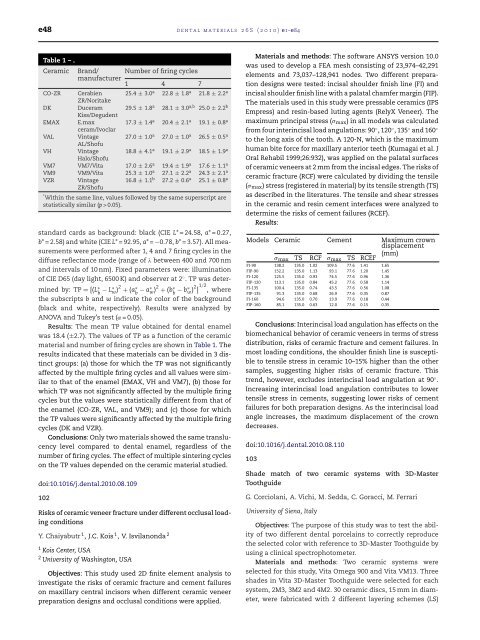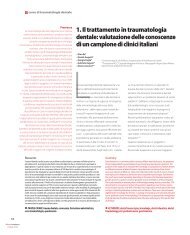Abstracts of the Academy of Dental Materials Annual ... - IsiRed
Abstracts of the Academy of Dental Materials Annual ... - IsiRed
Abstracts of the Academy of Dental Materials Annual ... - IsiRed
You also want an ePaper? Increase the reach of your titles
YUMPU automatically turns print PDFs into web optimized ePapers that Google loves.
e48 dental materials 26S (2010) e1–e84<br />
Table1–.<br />
Ceramic Brand/ Number <strong>of</strong> firing cycles<br />
manufacturer<br />
1 4 7<br />
CO-ZR Cerabien<br />
ZR/Noritake<br />
25.4 ± 3.0a 22.8 ± 1.8a 21.8 ± 2.2a DK Duceram<br />
Kiss/Degudent<br />
29.5 ± 1.8a 28.1 ± 3.0a,b 25.0 ± 2.2b EMAX E.max<br />
ceram/Ivoclar<br />
17.3 ± 1.4a 20.4 ± 2.1a 19.1 ± 0.8a VAL Vintage<br />
AL/Sh<strong>of</strong>u<br />
27.0 ± 1.0a 27.0 ± 1.0a 26.5 ± 0.5a VH Vintage<br />
Halo/Sh<strong>of</strong>u<br />
18.8 ± 4.1a 19.1 ± 2.9a 18.5 ± 1.9a VM7 VM7/Vita 17.0 ± 2.6a 19.4 ± 1.9a 17.6 ± 1.1a VM9 VM9/Vita 25.3 ± 1.0a 27.1 ± 2.2a 24.3 ± 2.1a VZR Vintage<br />
ZR/Sh<strong>of</strong>u<br />
16.8 ± 1.1b 27.2 ± 0.6a 25.1 ± 0.8a * Within <strong>the</strong> same line, values followed by <strong>the</strong> same superscript are<br />
statistically similar (p > 0.05).<br />
standard cards as background: black (CIE L* = 24.58, a* = 0.27,<br />
b* = 2.58) and white (CIE L* = 92.95, a*=−0.78, b* = 3.57). All measurements<br />
were performed after 1, 4 and 7 firing cycles in <strong>the</strong><br />
diffuse reflectance mode (range <strong>of</strong> between 400 and 700 nm<br />
and intervals <strong>of</strong> 10 nm). Fixed parameters were: illumination<br />
<strong>of</strong> CIE D65 (day light, 6500 K) and observer at 2◦ . TP was determined<br />
by: TP = [(L∗ b − L∗w )2 + (a∗ b − a∗w )2 + (b∗ b − b∗w )2 ] 1/2<br />
, where<br />
<strong>the</strong> subscripts b and w indicate <strong>the</strong> color <strong>of</strong> <strong>the</strong> background<br />
(black and white, respectively). Results were analyzed by<br />
ANOVA and Tukey’s test (˛ = 0.05).<br />
Results: The mean TP value obtained for dental enamel<br />
was 18.4 (±2.7). The values <strong>of</strong> TP as a function <strong>of</strong> <strong>the</strong> ceramic<br />
material and number <strong>of</strong> firing cycles are shown in Table 1. The<br />
results indicated that <strong>the</strong>se materials can be divided in 3 distinct<br />
groups: (a) those for which <strong>the</strong> TP was not significantly<br />
affected by <strong>the</strong> multiple firing cycles and all values were similar<br />
to that <strong>of</strong> <strong>the</strong> enamel (EMAX, VH and VM7), (b) those for<br />
which TP was not significantly affected by <strong>the</strong> multiple firing<br />
cycles but <strong>the</strong> values were statistically different from that <strong>of</strong><br />
<strong>the</strong> enamel (CO-ZR, VAL, and VM9); and (c) those for which<br />
<strong>the</strong> TP values were significantly affected by <strong>the</strong> multiple firing<br />
cycles (DK and VZR).<br />
Conclusions: Only two materials showed <strong>the</strong> same translucency<br />
level compared to dental enamel, regardless <strong>of</strong> <strong>the</strong><br />
number <strong>of</strong> firing cycles. The effect <strong>of</strong> multiple sintering cycles<br />
on <strong>the</strong> TP values depended on <strong>the</strong> ceramic material studied.<br />
doi:10.1016/j.dental.2010.08.109<br />
102<br />
Risks <strong>of</strong> ceramic veneer fracture under different occlusal loading<br />
conditions<br />
Y. Chaiyabutr 1 , J.C. Kois 1 , V. Isvilanonda 2<br />
1 Kois Center, USA<br />
2 University <strong>of</strong> Washington, USA<br />
Objectives: This study used 2D finite element analysis to<br />
investigate <strong>the</strong> risks <strong>of</strong> ceramic fracture and cement failures<br />
on maxillary central incisors when different ceramic veneer<br />
preparation designs and occlusal conditions were applied.<br />
<strong>Materials</strong> and methods: The s<strong>of</strong>tware ANSYS version 10.0<br />
was used to develop a FEA mesh consisting <strong>of</strong> 23,974–42,291<br />
elements and 73,037–128,941 nodes. Two different preparation<br />
designs were tested: incisal shoulder finish line (FI) and<br />
incisal shoulder finish line with a palatal chamfer margin (FIP).<br />
The materials used in this study were pressable ceramics (IPS<br />
Empress) and resin-based luting agents (RelyX Veneer). The<br />
maximum principal stress ( max) in all models was calculated<br />
from four interincisal load angulations: 90 ◦ , 120 ◦ , 135 ◦ and 160 ◦<br />
to <strong>the</strong> long axis <strong>of</strong> <strong>the</strong> tooth. A 120-N, which is <strong>the</strong> maximum<br />
human bite force for maxillary anterior teeth (Kumagai et al. J<br />
Oral Rehabil 1999;26:932), was applied on <strong>the</strong> palatal surfaces<br />
<strong>of</strong> ceramic veneers at 2 mm from <strong>the</strong> incisal edges. The risks <strong>of</strong><br />
ceramic fracture (RCF) were calculated by dividing <strong>the</strong> tensile<br />
( max) stress (registered in material) by its tensile strength (TS)<br />
as described in <strong>the</strong> literatures. The tensile and shear stresses<br />
in <strong>the</strong> ceramic and resin cement interfaces were analyzed to<br />
determine <strong>the</strong> risks <strong>of</strong> cement failures (RCEF).<br />
Results:<br />
Models Ceramic Cement Maximum crown<br />
displacement<br />
(mm)<br />
max TS RCF max TS RCEF<br />
FI-90 138.2 135.0 1.02 109.5 77.6 1.41 1.65<br />
FIP-90 152.2 135.0 1.13 93.1 77.6 1.20 1.45<br />
FI-120 125.5 135.0 0.93 74.5 77.6 0.96 1.36<br />
FIP-120 113.1 135.0 0.84 45.2 77.6 0.58 1.14<br />
FI-135 100.4 135.0 0.74 43.5 77.6 0.56 1.08<br />
FIP-135 91.3 135.0 0.68 26.9 77.6 0.35 0.87<br />
FI-160 94.6 135.0 0.70 13.9 77.6 0.18 0.44<br />
FIP-160 85.1 135.0 0.63 12.0 77.6 0.15 0.35<br />
Conclusions: Interincisal load angulation has effects on <strong>the</strong><br />
biomechanical behavior <strong>of</strong> ceramic veneers in terms <strong>of</strong> stress<br />
distribution, risks <strong>of</strong> ceramic fracture and cement failures. In<br />
most loading conditions, <strong>the</strong> shoulder finish line is susceptible<br />
to tensile stress in ceramic 10–15% higher than <strong>the</strong> o<strong>the</strong>r<br />
samples, suggesting higher risks <strong>of</strong> ceramic fracture. This<br />
trend, however, excludes interincisal load angulation at 90 ◦ .<br />
Increasing interincisal load angulation contributes to lower<br />
tensile stress in cements, suggesting lower risks <strong>of</strong> cement<br />
failures for both preparation designs. As <strong>the</strong> interincisal load<br />
angle increases, <strong>the</strong> maximum displacement <strong>of</strong> <strong>the</strong> crown<br />
decreases.<br />
doi:10.1016/j.dental.2010.08.110<br />
103<br />
Shade match <strong>of</strong> two ceramic systems with 3D-Master<br />
Toothguide<br />
G. Corciolani, A. Vichi, M. Sedda, C. Goracci, M. Ferrari<br />
University <strong>of</strong> Siena, Italy<br />
Objectives: The purpose <strong>of</strong> this study was to test <strong>the</strong> ability<br />
<strong>of</strong> two different dental porcelains to correctly reproduce<br />
<strong>the</strong> selected color with reference to 3D-Master Toothguide by<br />
using a clinical spectrophotometer.<br />
<strong>Materials</strong> and methods: Two ceramic systems were<br />
selected for this study, Vita Omega 900 and Vita VM13. Three<br />
shades in Vita 3D-Master Toothguide were selected for each<br />
system, 2M3, 3M2 and 4M2. 30 ceramic discs, 15 mm in diameter,<br />
were fabricated with 2 different layering schemes (LS)



